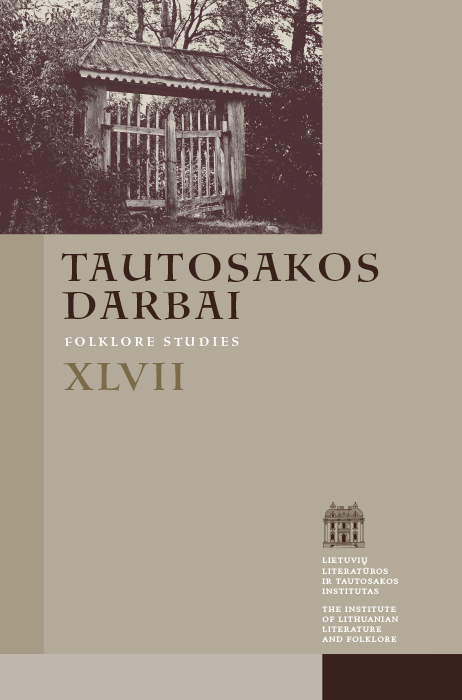The Lithuanian Legends of the Wild Hunt: Regarding Origins of the Image
Abstract
In the end of the 19th century, five Lithuanian folklore pieces describing the so-called Wild Hunt were recorded. In these narratives, the images of the hunt and the sounds made by the ranging souls are described. These texts, having been recorded in the territory inhabited by the so-called lietuvininkai (the Lithuania Minor) are truly unique. This land belonged to the Eastern Prussia at the time and having been for the long period separated from the major Lithuania and experiencing considerable German cultural influence, it acquired singular features.
So far the Lithuanian folklorists tended to interpret the legends in question as results of the German cultural influence. Yet the available folklore data only partly supports such opinion. The Lithuanian legends of the Wild Hunt are analyzed in the article by using the contextual information from the Baltic mythology, folklore, history and archeology. The motifs of the Wild Hunt are popular in the oral tradition of the European peoples, comprising specific imagery depicting a ghostlike hunting party ranging across the sky. Connections of this image with the cult of the deceased and the visions of the afterlife have been repeatedly established by the researchers.
The current analysis reveals that Lithuanian legends of the Wild Hunt are related to the German narratives of the Wilde Jagd not only in the name of this phenomenon. The Germanic influence can also be traced in the fact that the Wild Hunt is observed on high, since similar images are hard to find in the Lithuanian material. Other aspects of the phenomenon in question have parallels in the traditional Lithuanian worldview and can be deciphered on the grounds of the local folklore. Yet the origins of this image should perhaps be sought in the earlier layers of the Baltic culture.
The territory of the Lithuania Minor has for a long time been the native land of the western Baltic tribes – Prussians. Because of the assimilation processes and in result of a large number of the local population perishing in the plague, the ancient Prussian language became extinct as early as the beginning of the 18th century. Still the persistence of the Wild Hunt image in the worldview of the local Lithuanians of the 19th century can well be related to this cultural layer.
In striking correlation with the historical cultural facts recorded in the chronicles, the Prussian archeological data allows for assuming that local inhabitants used to imagine the afterlife journey of the deceased as a ride on a horseback, while endowed with all the military attributes. Yet this is valid only for the society members of the highest rank or the militants. Nevertheless in case of the Prussians, who used to live under the circumstances of almost ceaseless military campaigns, quite a number of mythical images could have incorporated the military thematic, thus forming distinct manifestations of the warriors’ mythology: the journey of the deceased to the afterworld on a horseback and with military equipment, the ghostlike army seen in the sky as an omen of the imminent war, etc. In L ithuanian mythology, such manifestations of the military worldview used to be best discerned in the 13th–14th centuries, when tensions caused by the threats to the safety and integrity of the land were most acutely experienced and the retaliatory military raids were frequently organized. This was also revealed in the contemporary pattern of the state gods, which reflected the ideology of the military layer of the society, while considerably lacking in representation of the lower rank of the deities (e. g. those in charge of the economic sphere). Such reflections of the military mythology could have well survived among the Lithuanian-speaking inhabitants of in the Lithuania Minor in the 19th century, when folklore collector Vilius Kalvaitis recorded the five legends in question there. It is reasonable to assume that such images used to become more prominent whenever fear and foreboding of the imminent war were felt, while persistence of such imagery was likewise supported by the existing similar Germanic notion of the Wilde Jagd.
Downloads
Most read articles by the same author(s)
- Jūratė Šlekonytė, The Folktale Narrator at the Turn of the 20th – 21st Century: the Case of Antanina Čaplikienė from Subartonys , Tautosakos darbai: Vol. 64 (2022)
- Jūratė Šlekonytė, Lithuanian Fairy Tale “Bearskin” (ATU 361): European Context and Local Peculiarities , Tautosakos darbai: Vol. 66 (2023): Tautosakos darbai
- Jūratė Šlekonytė, Women Storytellers and Peculiarities of Their Repertoire , Tautosakos darbai: Vol. 67 (2024): Tautosakos darbai
- Jūratė Šlekonytė, A Hundred Years of the Lithuanian Folktale Research: from the Traditional Comparativism to the Modern Methods , Tautosakos darbai: Vol. 49 (2015)
- Jūratė Šlekonytė, August Schleicher as the First Publisher of Lithuanian Folktales , Tautosakos darbai: Vol. 61 (2021)
- Jūratė Šlekonytė, The First Volumes of the Fundamental Edition of the Czech Folktales , Tautosakos darbai: Vol. 64 (2022)
- Jūratė Šlekonytė, Phenomenon of Popularity of the Lithuanian Folktale “The Sister as Duck” , Tautosakos darbai: Vol. 57 (2019)
- Jūratė Šlekonytė, A New Book on Wondertale Symbolism , Tautosakos darbai: Vol. 67 (2024): Tautosakos darbai
- Jūratė Šlekonytė, Do We Need Folktales? Bruno Bettelheim Answering , Tautosakos darbai: Vol. 55 (2018)
- Jūratė Šlekonytė, Folkloristics in the Digital Era: From Internet Folklore to Digital Archive , Tautosakos darbai: Vol. 58 (2019)




